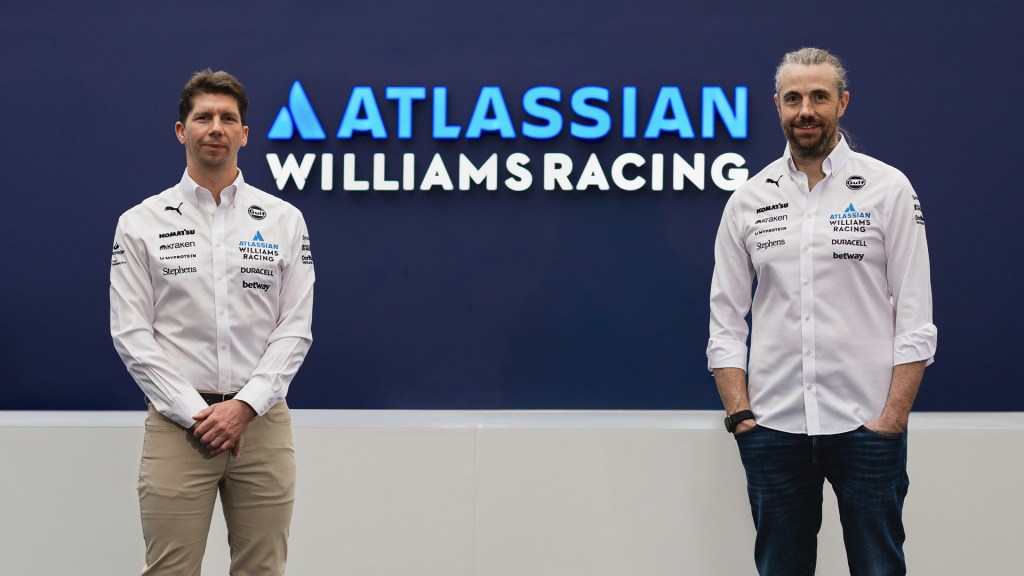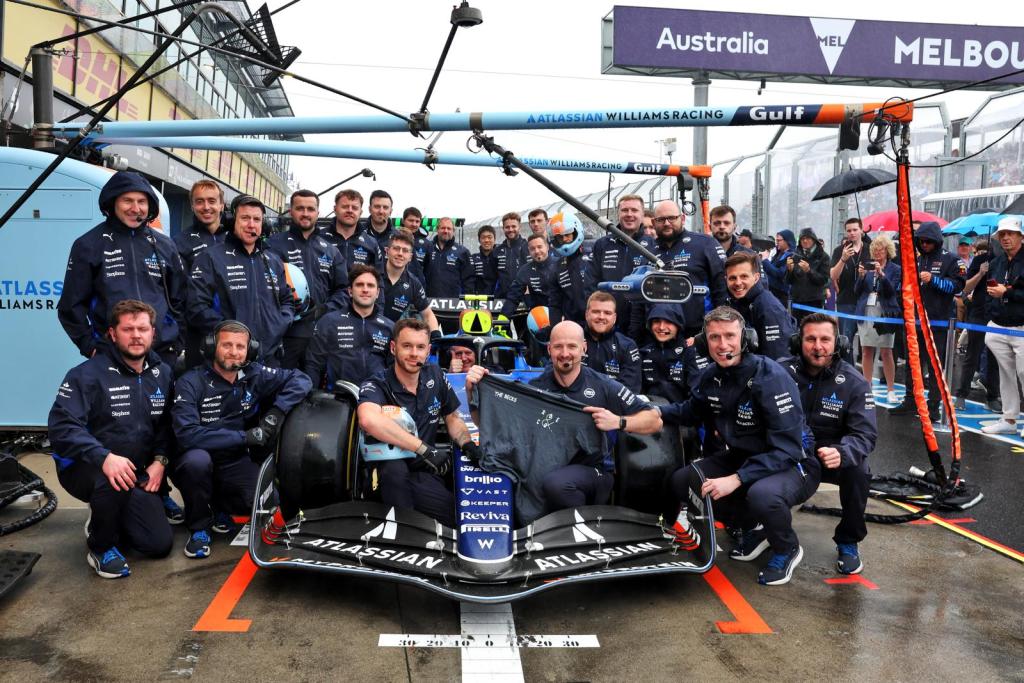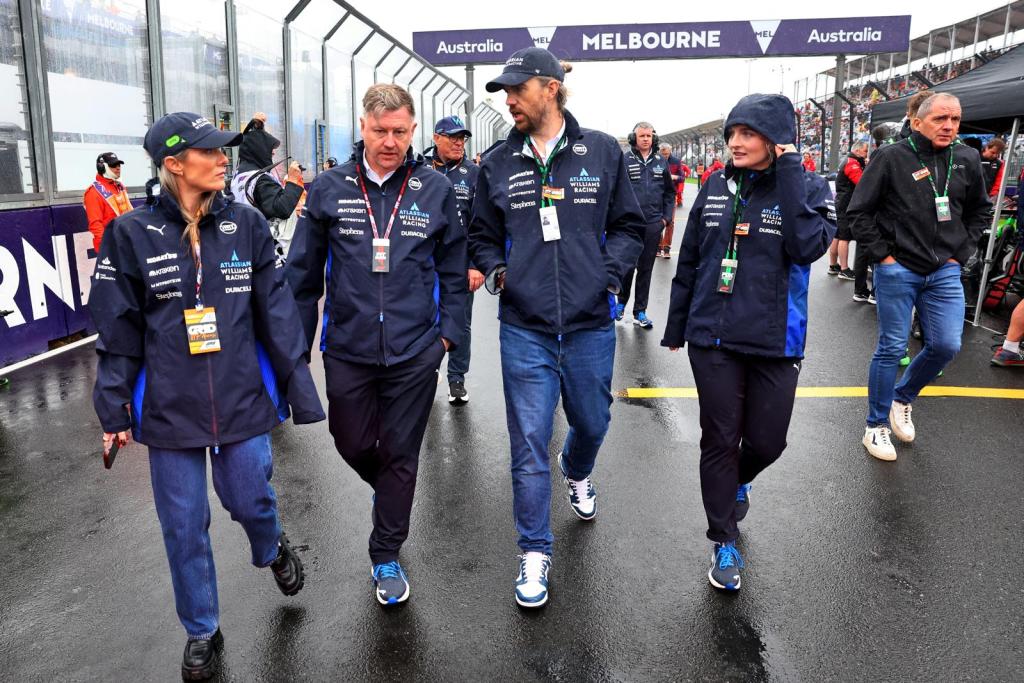Formula One is about to undergo its biggest transformation in decades. In 2026, the sport will introduce sweeping regulations aimed at making it safer, more sustainable, and more competitive. To stay ahead of the curve, Williams Racing has partnered with Sydney-headquartered Atlassian to help fast-track the team’s return to the front of the grid.

It’s a meeting of two iconic brands, pushing forward to optimise efficiency and operations. One emerged from Oxfordshire, England in 1977, and has since taken home nine Formula One Constructors Championships. The other was founded more than 17,000 kilometres away in Sydney, Australia, by two 22-year-old university graduates.
“This is one of the biggest partnerships in Formula One, it’s not just a logo on a car,” Mike Cannon-Brookes, co-founder and CEO of Atlassian, tells Forbes Australia. “It’s a deep partnership to try to improve the team’s position on the grid using the 20+ years of expertise that we have on teamwork and collaboration.”
Cannon-Brookes announced the multi-year title name partnership in February, ahead of the 2025 season opener in Melbourne. The collaboration between Atlassian and Williams represents the alignment of values within both organisations, Cannon-Brookes says, and is integral to the F1 team that placed 9th last year, to progress forward.
“They have a desire to transform. They need to lean on technology to help them. And that’s where we come in,” says Brian Duffy, Atlassian’s Chief Revenue Officer. “The rules are changing in Formula 1 in 2026. There’s a big opportunity for us to help the team embrace the new rules and technology as they roll into next year.”

The F1 regulation changes are a part of the motorsport’s commitment to have a Net Zero carbon footprint by the end of the decade. Those goals were announced in 2019, and mandate that significant changes to the vehicles, fuel, transportation, and logistics take place by 2026.
“Revised aerodynamic regulations will work in tandem with new power unit rules, which include increased battery power and the use of 100% sustainable fuels,” a statement from F1 governing body, FIA, reads.
“We have opted for a higher electrical component of the power unit, a more efficient car overall, and fully sustainable fuels, as part of our drive towards a more sustainable future for our sport,” says FIA Technical Director, Nikolas Tombazis.
“Lighter, more powerful and more focused on driver skill, the 2026 FIA Formula One Technical Regulations have been designed to provide closer racing among drivers, increase the competition between teams and to improve the spectacle.”
What Atlassian is bringing to the Williams table
Six Atlassian team members are now working full-time on Atlassian Williams Racing, some of whom are embedded at the Oxfordshire headquarters of the team. One Atlassian team member will travel to all 24 F1 races on the circuit and spend time in the garage on race days.
The Australian-teams-driven tech company says Williams is now at an inflection point and needs internal transformation to get back to the front of the grid.
“From a customer perspective, we’re in the investigation phase,” says Duffy. “We have already transitioned their applications to the cloud. The goal is for us to understand and fix the challenges that the folks at the top have, all the way down to those on the shop floor.”
Atlassian’s ‘System of Work’ will be implemented throughout the racing team to enable a ‘deliberate teamwork approach.’
Innovating and transforming is fundamental to F1 success, Duffy says.
“In terms of being data-driven and tech-focused teams, they’re in a very unique position and sport compared to others. They need to be constantly reimagining themselves and pushing boundaries from a technology perspective.”
The highly technical component of F1 is a part of what drew Atlassian to this particular partnership. The cultural fit with the Williams team was also imperative.
“There is a desire to think outside the box at Williams, a desire to reimagine what the business can look like. For us in the technology industry, we love to partner with organisations who don’t want to just implement best practices, but actually reimagine what best practices are,” says Duffy.

The 750 million F1 fan opportunity, and conundrum
When it comes to reaching an international audience, the opportunity that F1 represents is unmatched. Interest in F1 motorsport has grown by almost 6 per cent, or 50 million people, in just 3 years, according to Nielsen Sports research released in December, making it the fastest growing sport in the world.
A key driver of that growth is audiences in the Middle East, where there are now four races. Women between 16 and 24 are the fastest-growing demographic. Currently, forty-one per cent of F1 fans are female.
Netflix’s Drive to Survive has also propelled the sport into another stratosphere, documenting recent additions to the F1 calendar in Austin, Miami, and Las Vegas.
“Mike and the executive team were looking at an opportunity to increase the brand awareness for Atlassian,” says Duffy. “We looked at various options and then met with the Williams team and found a partner that we really connected with culturally.”
Cannon-Brookes, who is known for his commitment to improving global environmental outcomes, and Atlassian’s Chief Sustainability Officer, Jessica Hyman, say Williams is leading the way in the F1 journey toward sustainability.
“They’re the first F1 team to sign the UNFCCC Sports for Climate Action Framework and have earned the impressive FIA 3-star environmental accreditation,” says Hyman. “Williams also just rolled out a bold sustainability strategy that’s focused on tackling some of the biggest environmental and societal challenges we face, including reducing waste and water usage.”
Cannon-Brookes acknowledges that the partnership with a fuel-heavy sport may raise eyebrows, given his unyielding orientation toward sustainability.

“I’ve had conversations with the FIA and am impressed with their plans to get to net zero,” Cannon-Brookes writes on LinkedIn. “They’ve shown consistent commitment (the 2026 cars are 50% electric, 50% combustion engine, and running on sustainable fuel). Atlassian Williams Racing is even further along (see their Sustainability Report). Their drive to net zero mirrors Atlassian’s own journey.”
Duffy says the reach that F1 has, and the goals it has set, allow the Australian unicorn to target a coveted demographic at the very top of organisations.
“When we look at partnership opportunities to increase the brand of Atlassian, there’s a limited pool of opportunities. F1 is certainly at the top of the list when you look at the decision-makers from organisations who will attend events like this. It certainly stands out compared to other opportunities,” says Duffy.
The Irish-born executive intends to make Williams Racing team a ‘posterchild’ for what partnering with Atlassian can accomplish. The 750 million fans watching the behind-the-scenes drama on Drive to Survive unfold, or live races in the paddock and on live tv, doesn’t hurt either.
“It enables us to demonstrate to our global customers what we are physically doing as their technology partner, and highlight what Atlassian does for business teams, in a very visceral way,” says Cannon-Brookes.
2026 changes to F1 regulations
- More agile cars, which are 30kg lighter and thus better able to battle on track
- A redesigned power unit featuring increased battery power and an even split between internal combustion engine and electric power plus the use of 100% sustainable fuels
- Active aerodynamics in the form of moveable front and rear wings to allow for closer racing
- Increased overtaking opportunities through the introduction of a new system that gives drivers a short burst of additional battery power when within one second of the car in front
- Improved safety through stronger structures and even tougher tests
- Commitment from a record number of six power unit manufacturers



